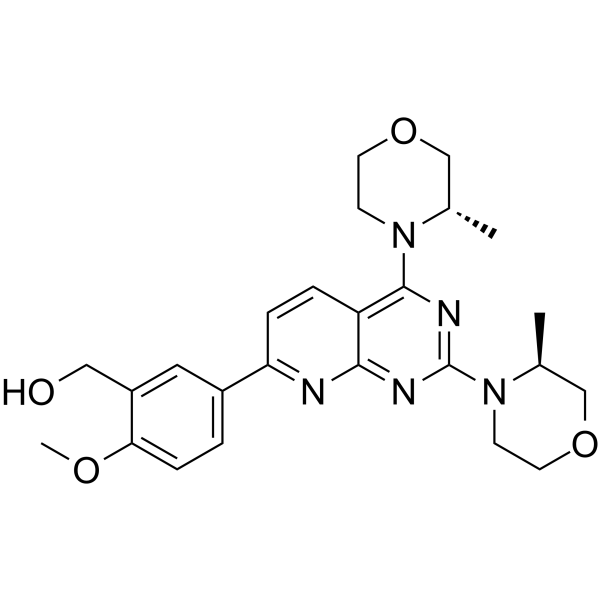上海金畔生物科技有限公司为生命科学和医药研发人员提供生物活性分子抑制剂、激动剂、特异性抑制剂、化合物库、重组蛋白,专注于信号通路和疾病研究领域。
AZD-8055 纯度: 99.60%
AZD-8055 是一种有效、选择性、具有口服活性和 ATP 竞争性的 mTOR 抑制剂,IC50 为 0.8 nM。AZD-8055 抑制 mTORC1 和 mTORC2。

AZD-8055 Chemical Structure
CAS No. : 1009298-09-2
| 规格 | 价格 | 是否有货 | 数量 |
|---|---|---|---|
| Free Sample (0.1-0.5 mg) | Apply now | ||
| 10 mM * 1 mL in DMSO | ¥572 | In-stock | |
| 5 mg | ¥520 | In-stock | |
| 10 mg | ¥884 | In-stock | |
| 50 mg | ¥2100 | In-stock | |
| 100 mg | ¥3580 | In-stock | |
| 200 mg | ¥5800 | In-stock | |
| 500 mg | 询价 | ||
| 1 g | 询价 |
* Please select Quantity before adding items.
AZD-8055 相关产品
•相关化合物库:
- Clinical Compound Library Plus
- Bioactive Compound Library Plus
- Apoptosis Compound Library
- Kinase Inhibitor Library
- PI3K/Akt/mTOR Compound Library
- Stem Cell Signaling Compound Library
- Anti-Cancer Compound Library
- Clinical Compound Library
- Autophagy Compound Library
- Anti-Aging Compound Library
- Antioxidants Compound Library
- Differentiation Inducing Compound Library
- Reprogramming Compound Library
- Oxygen Sensing Compound Library
- Glycolysis Compound Library
- Cytoskeleton Compound Library
- Orally Active Compound Library
- Glutamine Metabolism Compound Library
- Anti-Breast Cancer Compound Library
- Anti-Lung Cancer Compound Library
- Anti-Pancreatic Cancer Compound Library
- Anti-Blood Cancer Compound Library
- Anti-Cancer Metabolism Compound Library
- Angiogenesis Related Compound Library
- Lipid Metabolism Compound Library
- Glucose Metabolism Compound Library
- Anti-Liver Cancer Compound Library
- Anti-Colorectal Cancer Compound Library
| 生物活性 |
AZD-8055 is a potent, selective, and orally bioavailable ATP-competitive mTOR kinase inhibitor with an IC50 of 0.8 nM. AZD-8055 inhibits both mTORC1 and mTORC2[1]. |
||||||||||||||||
|---|---|---|---|---|---|---|---|---|---|---|---|---|---|---|---|---|---|
| IC50 & Target |
|
||||||||||||||||
| 体外研究 (In Vitro) |
The inhibitory activity of AZD-8055 (AZD8055) against mTOR is evaluated using two different assays. Using the truncated recombinant mTOR enzyme, the IC50 for AZD8055 is 0.13±0.05 nM. Using native mTOR enzyme complexes extracted from HeLa cells, the IC50 is 0.8±0.2 nM. AZD-8055 shows excellent selectivity (~1,000-fold) against all class I PI3K isoforms and other members of the PI3K-like kinase family. AZD-8055 inhibits the phosphorylation of mTORC1 substrates p70S6K and 4E-BP1 as well as phosphorylation of the mTORC2 substrate AKT and downstream proteins. The cellular IC50s for AZD8055 are calculated as 24±9 nM (n=13) for pAKT Ser473 and 27±3 nM (n=12) for pS6 Ser235/236 in MDA-MB-468 cells[1]. 上海金畔生物科技有限公司 has not independently confirmed the accuracy of these methods. They are for reference only. |
||||||||||||||||
| 体内研究 (In Vivo) |
In mice bearing U87-MG (PTEN null) glioblastoma xenografts, oral treatment with AZD-8055 (AZD8055) results in a dose-dependent tumor growth inhibition of 33%, 48%, and 77% with 2.5, 5, and 10 mg/kg/d twice daily, respectively. A similar dose dependency is observed in nude mice bearing A549 xenografts: tumor growth inhibition is 44%, 55%, and 93% after 2.5, 5, and 10 mg/kg/d twice daily, respectively. AZD8055 also results in significant inhibition of tumor growth and/or regression in breast, lung, colon, prostate, and uterine xenograft models when administered either twice daily at 10 mg/kg or daily at a dose of 20 mg/kg[1]. AZD8055 markedly decreases the phosphorylation levels of mTOR and its substrates and the activation of microglia in vivo, and promotes the microglial polarization from M1 phenotype to M2 phenotype. In addition, administration of AZD8055 following subarachnoid hemorrhage (SAH) significantly ameliorates EBI, including neuronal apoptosis, neuronal necrosis, brain edema and blood-brain barrier permeability[2]. 上海金畔生物科技有限公司 has not independently confirmed the accuracy of these methods. They are for reference only. |
||||||||||||||||
| Clinical Trial |
|
||||||||||||||||
| 分子量 |
465.54 |
||||||||||||||||
| Formula |
C25H31N5O4 |
||||||||||||||||
| CAS 号 |
1009298-09-2 |
||||||||||||||||
| 运输条件 |
Room temperature in continental US; may vary elsewhere. |
||||||||||||||||
| 储存方式 |
|
||||||||||||||||
| 溶解性数据 |
In Vitro:
DMSO : 200 mg/mL (429.61 mM; Need ultrasonic) 配制储备液
*
请根据产品在不同溶剂中的溶解度选择合适的溶剂配制储备液;一旦配成溶液,请分装保存,避免反复冻融造成的产品失效。 In Vivo:
请根据您的实验动物和给药方式选择适当的溶解方案。以下溶解方案都请先按照 In Vitro 方式配制澄清的储备液,再依次添加助溶剂: ——为保证实验结果的可靠性,澄清的储备液可以根据储存条件,适当保存;体内实验的工作液,建议您现用现配,当天使用; 以下溶剂前显示的百
|
||||||||||||||||
| 参考文献 |
|
| Kinase Assay [1] |
Inhibition of mTOR is evaluated using two methodologies: The high-throughput assay uses an α screen capture complex technology with a recombinant truncated FLAG-tagged mTOR (amino acids 1362-2549; expressed in HEK293 cells) and a biotinylated p70 peptide substrate. In addition, native mTOR activity is assayed using immunoprecipitation of full-length mTOR from HeLa cytoplasmic extract, and the endogenous mTOR is in protein complexes with Rictor and Raptor. A kinase assay is performed in the presence of recombinant 4E-BP1 protein as substrate with detection of the phosphorylated product through an ELISA format. The activity of the lipid kinases, class I PI3Ks α, β, δ, and γ, is measured using recombinant PI3Ks with the lipid PIP2 as substrate. Assays for the ataxia-telangiectasia mutated (ATM) and DNA-PK are performed. Finally, counterscreen against 260 kinases is carried out at a fixed concentration of 10 μM AZD-8055[1]. 上海金畔生物科技有限公司 has not independently confirmed the accuracy of these methods. They are for reference only. |
|---|---|
| Cell Assay [1] |
For growth inhibition and acridine staining, cells are exposed to increasing concentrations of AZD-8055 (0 to 1,280 nM) for 72 to 96 h and stained for cell nuclei (0.03 mg/mL Hoechst 33342) and acidic vesicles (1 μg/mL acridine orange). Images are captured at 450 and 536 nm on an ArrayScan II platform, and the percentage of acidic vesicles and the number of cells are quantified. For LC3 assessment, cells are exposed to e64d/pepstatin (10 μg/mL) for 30 to 90 min before incubation with AZD8055. Cells are lysed on ice and analyzed by immunoblotting[1]. 上海金畔生物科技有限公司 has not independently confirmed the accuracy of these methods. They are for reference only. |
| Animal Administration [1][2] |
Mice[1] 上海金畔生物科技有限公司 has not independently confirmed the accuracy of these methods. They are for reference only. |
| 参考文献 |
|
所有产品仅用作科学研究或药证申报,我们不为任何个人用途提供产品和服务
